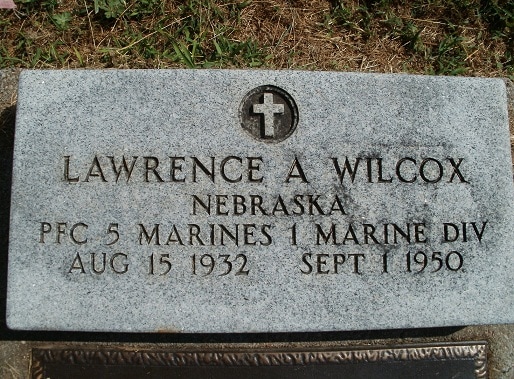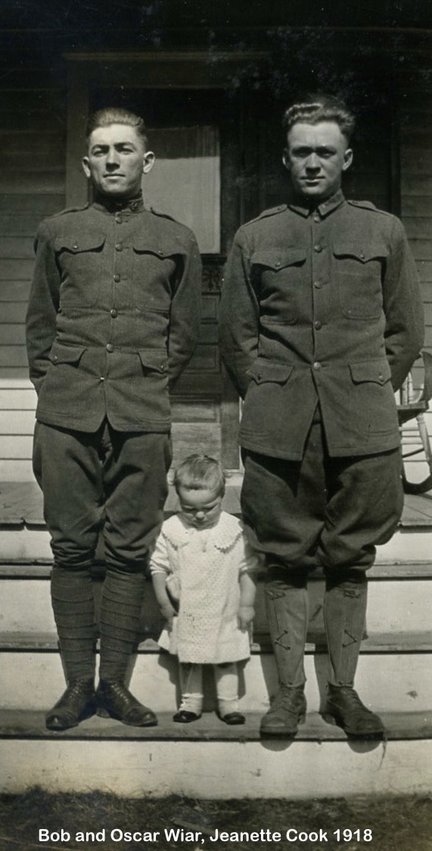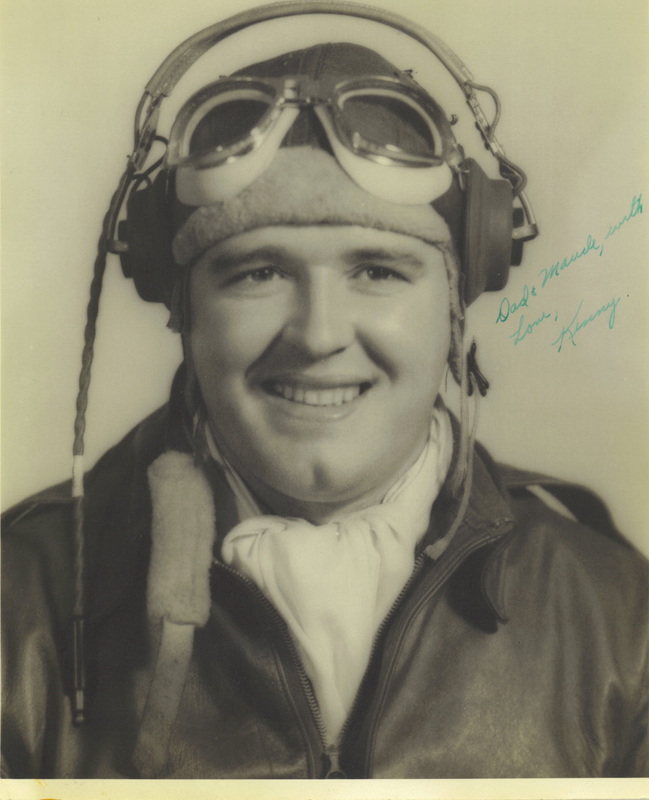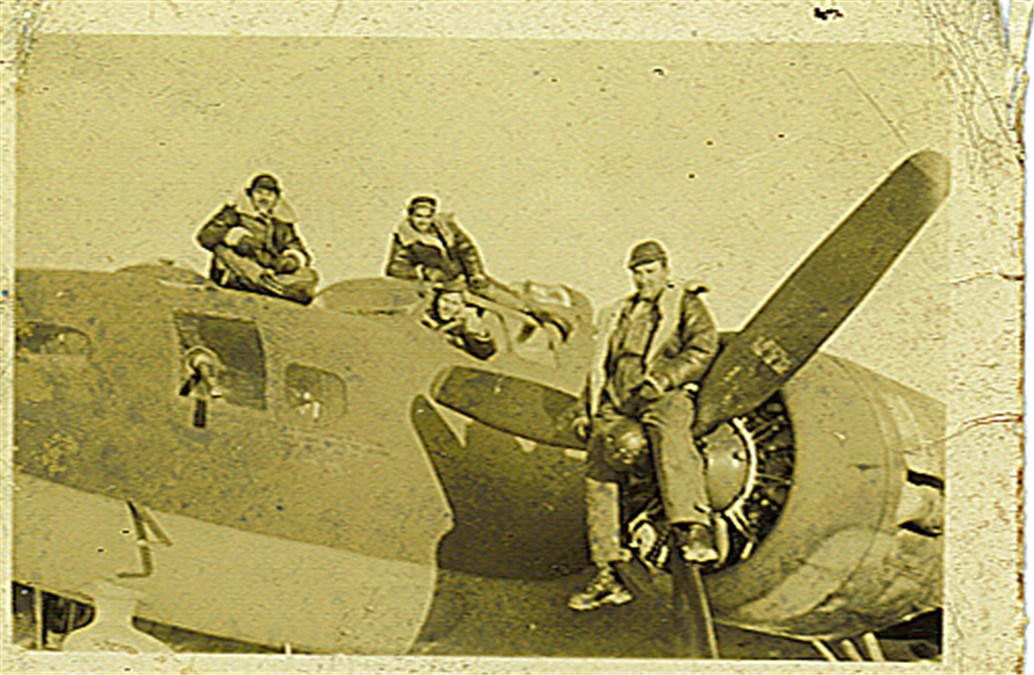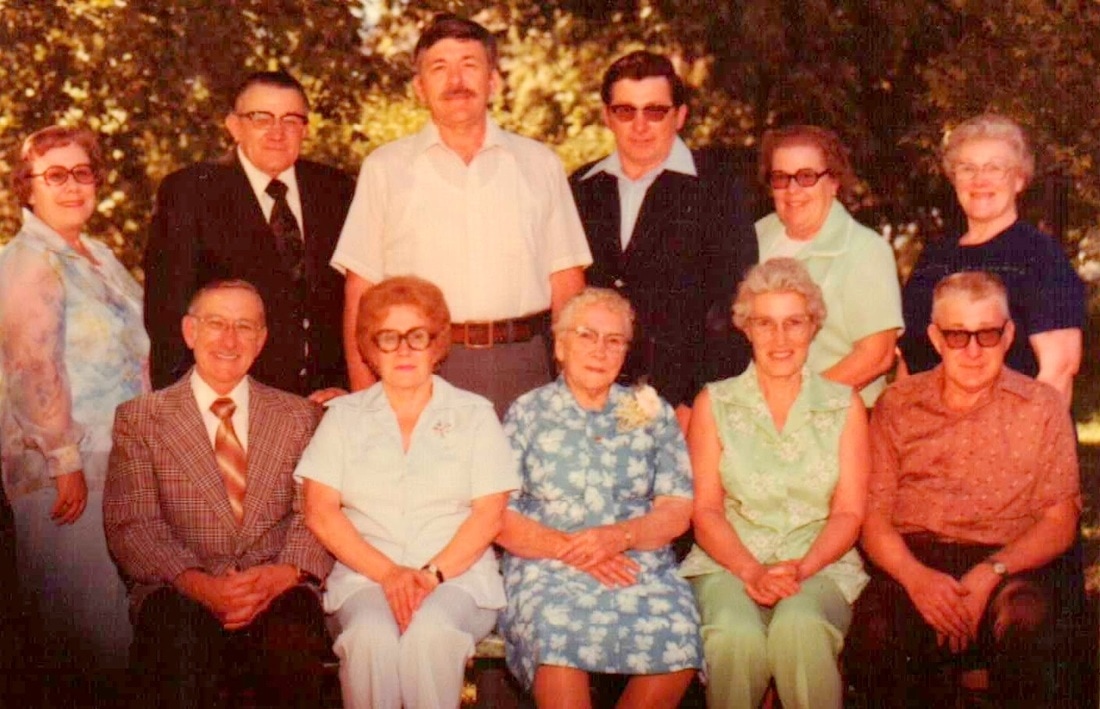lawrence wilcox
worth remembering
lawrence WILCOX
A FALLEN SOLDIER OF THE KOREAN WAR
by Sharla Sitzman
Forward: Lawrence's family lived in both Table Rock and Steinauer and is claimed by both. He attended schools in both towns at one time or another and four of his siblings graduated from Table Rock. There is no battle over this young Marine but rather a joining of forces to honor him. The Steinauer Heritage House has gathered memories and information about him. Included are the memories of Marjorie Obrist Morrissey- Steinauer Class of 53; Sue Steinauer Miles- Steinauer Class of 1953; Ethelreda Gottula Pella- Steinauer Class of 1948; Kay Steinauer Wehrbein-‘Steinaurer Class of 1949; Bob Steinauer- Steinauer Class of 1952; Jim Wenzl, Steinauer Class of 1945; and Don Wenzl, Steinauer Class of 1949. Lawrence Obrist of Steinauer played a large part in gathering this information, and we thank him. Nieces Carrie Wilcox Farset and Sherry Wilcox provided much personal information about the family, including photographs, and for that invaluable information, we thank them as well.
|
Lawrence Wilcox was a young man who died 70 years ago, 6,000 miles from home. It was in the earliest days of the Korean Conflict, often now called the “Forgotten War."
Lawrence A. Wilcox (1932 - 1950) was the youngest of the dozen children of Addie and Ernest Wilcox. The ones older than him were Herald, Richard, Lyle, Robert, Ruth, Doris, Jean, Dorothy, Lourain, Lucille and David. His mother, Addie, had graduated from Table Rock in 1911. Some of her children went to Table Rock, too. Lawrence and his brother Lyle appear in a picture of the basketball team taken in the Fall of 1947. Lyle graduated at the end of that school year, the last of four siblings to graduate from Table Rock. |
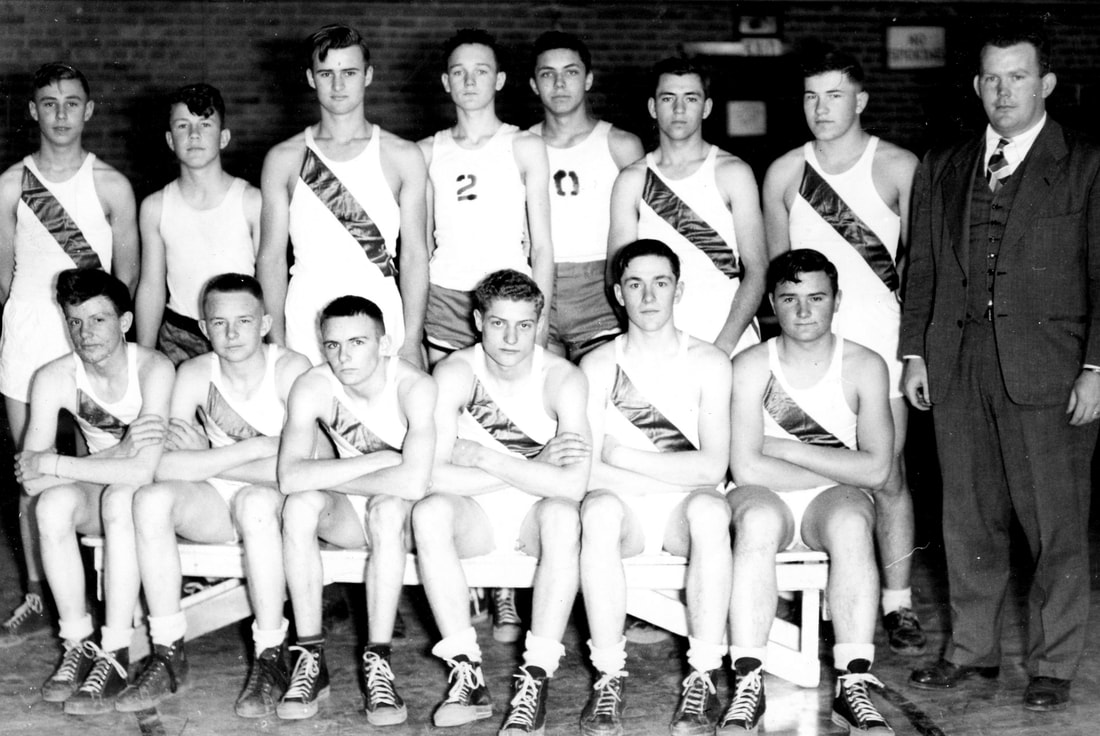
Table Rock's 1947 basketball team. Lawrence is the player in the back row, far right. His brother Lyle is in the front row, 5th from the left. Photo 3971.
ALL OF THE NAMES. Back row: Richard Giles, Richard Karas, Marion Kalina, Junior Karas, Eldon Petersak, Bob Slaughter, Lawrence Wilcox.
Front Row: Red Carter, Leland Covault, LaVon Covault, Norris Gold, Lyle Wilcox, Myron Kent. Coach Jerry Stemper
|
The family then moved to a farm north of Steinauer, near the Wenzl families' farms.
Some Steinauer memories: Lawrence was well known to Jim and Don Wenzl of Steinauer as a bit of a wild and fun loving kid. His transportation from home to school or town was his horse. He took a shine to Shirley Steiner Morehead who also rode a horse from her home southwest of Steinauer for high school. Both boarded their horses during the school day at the barn of Norbert Steinauer. |
Not so long after Ken Wiar's death, Lawrence joined the Marines. He was 17. It was October 1949. He had one leave before deployment after boot camp in San Diego, according to niece Carrie Wilcox Farset, daughter of Lawrence’s brother Lyle. That is when a photo of Lawrence in front of an automobile was taken. He is in uniform and stands proud. He went to a dance in the Community Building in Tecumseh during that leave.
By the summer, Lawrence’s life would fast forward to its end.
On June 25, 1950, North Korea attacked South Korea. South Korean forces buckled and within three days had taken the capital city of Seoul. The United States decided to intervene and the United Nations pledged to assist soon after. One commentator noted the disastrous entry of US troops: “A pronounced lack of preparedness in terms of equipment and deployable unit strength, along with hasty introduction of forces into battle, led to an initial retreat and a large number of casualties in the first weeks of the intervention.”
On August 1, the US forces withdrew to an area around the port of Pusan, an important logistical hub that was deep in South Korea. If the north Koreans could get past there, they could take the whole peninsula. Intense fighting followed. A defense perimeter was thrown up in that area and it would see intense fighting.
In the meantime, the military was in a panic to get troops in place. They were shipped out as quickly as possible. Lawrence’s unit was on its way within three weeks after the North Korean attack.
The plan was for the arriving troops to go first to Japan for training and preparations. However, the Americans were fighting desperately to hold the perimeter line at Pusan, and Lawrence’s unit did not stop in Japan for the expected training and preparation.
They went straight to Korea and straight into combat. Lawrence's unit, attached to the Army’s 25th Infantry Division, was immediately involved in the battles of the Chindong-ni-Sachon offensive.
On August 12, the North Koreans “infiltrated” a regiment in the Task Force's rear, an event known as the Changcon Ambush. Half of the 29th Infantry Division had been wiped out in such an ambush about two weeks before. The Pusan area was in chaos.
On August 13, 1950 -- less than two weeks after arriving in Korea and two days before he was to turn 18, Lawrence was listed as missing in action.
Where was he on his 18th birthday, August 15? He was somewhere in that mass of American troops battling to stop the North Koreans before they got farther south than Pusan. The tide would changer on September 15, 1950 with the landing of additional troops at Inchon. That was too late for Lawrence.
It was later determined that Lawrence had been alive until September 1, 1950. At that time, his unit was defending its position on Hill 202, which overlooked the Sachon River near Sachon, South Korea. There in that place far away from the family farm in Pawnee County, Lawrence Wilcox was killed. The fun-loving kid who was a “a bit wild,” the boy who had played basketball at Table Rock, was dead. A family of 12 was one child less.
It took almost 10 months for Lawrence’s body to reach home for burial. His niece Carrie Wilcox Farset gave me a copy of a letter written by Addie Wilcox to her daughter Lucille about Lawrence’s funeral.
Addie wrote that “all the business houses” closed at 1:45 in Lawrence’s memory. The hearse was parked in the center of the street in front of the funeral home and she and Ernie, in their son Lyle’s car, pulled in behind it.
The color guard stood in front of the hearse with the American flag and Marine flag.
“There was a little Army sergeant visiting in T.R. while home on leave and he had stayed for the funeral. That “little sergeant,” whoever he was, gave orders for 14 American Legion men to form 2 lines from the door of the funeral home to the hearse. As 6 Marines brought the casket out, all were at attention.”
There was a procession then that went up the west side of the Square to the Methodist church. The color guard led, and next came a chaplain and “Marion Bonham, TR banker,” both in Navy uniform, who walked just head of the hearse. “The pall bearers marched 3 on each side of the hearse and the 14 Legion men came next with the little Sergeant to one side to give orders. We followed and all went to the church.”
During the funeral, “The color guard stood at attention, two at each side of the casket.”
Afterward, as the mourners followed the casket from the church, “the color guard and the Legion formed 2 lines from the church to the hearse, with flags touching, for the casket to be carried through.”
A procession to the cemetery, led by the color guard, was followed by the family in cars.
At the cemetery, the Legion “marched to 2 sides of the grave and the Marines were all at attention.”
Addie wrote that following the chaplain’s prayers, “the firing squad did their part and Marion Bonham blew the bugle and of course it was echoed. The Marines then folded the flag and gave it to me.”
Addie said, “It was the grandest tribute ever paid to anyone in T.R.”
When Lawrence had been home on leave before he left for Korea, his death was the family’s worst nightmare. Lawrence himself, being 17, may not have contemplated being the center of the town’s attention in that way.
Certainly when Lawrence joined the Marines he did not plan to be in a war nor dead by his 18th birthday.
But he did plan to serve his country, a long tradition in his extended family, service and sacrifice. He joined his cousins Delmar Wilcox and Kenneth Wiar when he gave all.
Lawrence’s brother Lyle served in Korea, as did Lawrence's cousin Earl Wilcox. And his brother Robert was a Marine who was on his way to Korea when the treaty was signed. This was fortunate timing for another Table Rock Marine, too; machine gunner Rudy Fritch's unit was likewise on the way at that time.
Whenever you stop to think about the freedoms you enjoy, please pause to think of people like Lawrence Wilcox who have put themselves in harm’s way to protect the freedom of strangers. And remember the families who they left behind.
By the summer, Lawrence’s life would fast forward to its end.
On June 25, 1950, North Korea attacked South Korea. South Korean forces buckled and within three days had taken the capital city of Seoul. The United States decided to intervene and the United Nations pledged to assist soon after. One commentator noted the disastrous entry of US troops: “A pronounced lack of preparedness in terms of equipment and deployable unit strength, along with hasty introduction of forces into battle, led to an initial retreat and a large number of casualties in the first weeks of the intervention.”
On August 1, the US forces withdrew to an area around the port of Pusan, an important logistical hub that was deep in South Korea. If the north Koreans could get past there, they could take the whole peninsula. Intense fighting followed. A defense perimeter was thrown up in that area and it would see intense fighting.
In the meantime, the military was in a panic to get troops in place. They were shipped out as quickly as possible. Lawrence’s unit was on its way within three weeks after the North Korean attack.
The plan was for the arriving troops to go first to Japan for training and preparations. However, the Americans were fighting desperately to hold the perimeter line at Pusan, and Lawrence’s unit did not stop in Japan for the expected training and preparation.
They went straight to Korea and straight into combat. Lawrence's unit, attached to the Army’s 25th Infantry Division, was immediately involved in the battles of the Chindong-ni-Sachon offensive.
On August 12, the North Koreans “infiltrated” a regiment in the Task Force's rear, an event known as the Changcon Ambush. Half of the 29th Infantry Division had been wiped out in such an ambush about two weeks before. The Pusan area was in chaos.
On August 13, 1950 -- less than two weeks after arriving in Korea and two days before he was to turn 18, Lawrence was listed as missing in action.
Where was he on his 18th birthday, August 15? He was somewhere in that mass of American troops battling to stop the North Koreans before they got farther south than Pusan. The tide would changer on September 15, 1950 with the landing of additional troops at Inchon. That was too late for Lawrence.
It was later determined that Lawrence had been alive until September 1, 1950. At that time, his unit was defending its position on Hill 202, which overlooked the Sachon River near Sachon, South Korea. There in that place far away from the family farm in Pawnee County, Lawrence Wilcox was killed. The fun-loving kid who was a “a bit wild,” the boy who had played basketball at Table Rock, was dead. A family of 12 was one child less.
It took almost 10 months for Lawrence’s body to reach home for burial. His niece Carrie Wilcox Farset gave me a copy of a letter written by Addie Wilcox to her daughter Lucille about Lawrence’s funeral.
Addie wrote that “all the business houses” closed at 1:45 in Lawrence’s memory. The hearse was parked in the center of the street in front of the funeral home and she and Ernie, in their son Lyle’s car, pulled in behind it.
The color guard stood in front of the hearse with the American flag and Marine flag.
“There was a little Army sergeant visiting in T.R. while home on leave and he had stayed for the funeral. That “little sergeant,” whoever he was, gave orders for 14 American Legion men to form 2 lines from the door of the funeral home to the hearse. As 6 Marines brought the casket out, all were at attention.”
There was a procession then that went up the west side of the Square to the Methodist church. The color guard led, and next came a chaplain and “Marion Bonham, TR banker,” both in Navy uniform, who walked just head of the hearse. “The pall bearers marched 3 on each side of the hearse and the 14 Legion men came next with the little Sergeant to one side to give orders. We followed and all went to the church.”
During the funeral, “The color guard stood at attention, two at each side of the casket.”
Afterward, as the mourners followed the casket from the church, “the color guard and the Legion formed 2 lines from the church to the hearse, with flags touching, for the casket to be carried through.”
A procession to the cemetery, led by the color guard, was followed by the family in cars.
At the cemetery, the Legion “marched to 2 sides of the grave and the Marines were all at attention.”
Addie wrote that following the chaplain’s prayers, “the firing squad did their part and Marion Bonham blew the bugle and of course it was echoed. The Marines then folded the flag and gave it to me.”
Addie said, “It was the grandest tribute ever paid to anyone in T.R.”
When Lawrence had been home on leave before he left for Korea, his death was the family’s worst nightmare. Lawrence himself, being 17, may not have contemplated being the center of the town’s attention in that way.
Certainly when Lawrence joined the Marines he did not plan to be in a war nor dead by his 18th birthday.
But he did plan to serve his country, a long tradition in his extended family, service and sacrifice. He joined his cousins Delmar Wilcox and Kenneth Wiar when he gave all.
Lawrence’s brother Lyle served in Korea, as did Lawrence's cousin Earl Wilcox. And his brother Robert was a Marine who was on his way to Korea when the treaty was signed. This was fortunate timing for another Table Rock Marine, too; machine gunner Rudy Fritch's unit was likewise on the way at that time.
Whenever you stop to think about the freedoms you enjoy, please pause to think of people like Lawrence Wilcox who have put themselves in harm’s way to protect the freedom of strangers. And remember the families who they left behind.
his death notice in the argus
Table Rock Argus, July 5, 1951.
Military Funeral Set For Friday
COMMUNITY TO PAY LAST RESPECTS FOR MARINE WHO DIED IN ACTION IN KOREA
A full Military Funeral will be held Friday of this week for Pfc. Lawrence A. Wilcox, son of Mr. and Mrs. Earnest Wilcox of the Steinauer community, who was killed in action in August, 1950, while fighting with the Marines in Korea. He was 18 years old.
Services will be held in the Methodist Church in Table Rock Friday afternoon at 2:00 p.m. with Rev. Oden of Hickman, Nebraska, Reserve Marine Chaplain, conducting the services, assisted by Rev. E. P. Booher of Elk Creek.
Marine pallbearers, a Marine Color Guard, and a local Legion Post firing squad will be included in the final rites. Local Legion Post members met the body at the train Wednesday afternoon and escorted it to the Kovanda-Beethe Funeral Home. Burial will be made in the Table Rock cemetery.
Lawrence Wilcox joined the Marines in October, 1949, and after basic training was sent to Korea, where he was listed as missing in action on August 13, 1950. On September 1, 1950, the War Department reported him as having been killed.
Wilcox attended grade school in Table Rock and had attended high school here before enlisting with the Marines.
Table Rock business places will close from 1:45 to 3:00 p.m. during the funeral services.
Military Funeral Set For Friday
COMMUNITY TO PAY LAST RESPECTS FOR MARINE WHO DIED IN ACTION IN KOREA
A full Military Funeral will be held Friday of this week for Pfc. Lawrence A. Wilcox, son of Mr. and Mrs. Earnest Wilcox of the Steinauer community, who was killed in action in August, 1950, while fighting with the Marines in Korea. He was 18 years old.
Services will be held in the Methodist Church in Table Rock Friday afternoon at 2:00 p.m. with Rev. Oden of Hickman, Nebraska, Reserve Marine Chaplain, conducting the services, assisted by Rev. E. P. Booher of Elk Creek.
Marine pallbearers, a Marine Color Guard, and a local Legion Post firing squad will be included in the final rites. Local Legion Post members met the body at the train Wednesday afternoon and escorted it to the Kovanda-Beethe Funeral Home. Burial will be made in the Table Rock cemetery.
Lawrence Wilcox joined the Marines in October, 1949, and after basic training was sent to Korea, where he was listed as missing in action on August 13, 1950. On September 1, 1950, the War Department reported him as having been killed.
Wilcox attended grade school in Table Rock and had attended high school here before enlisting with the Marines.
Table Rock business places will close from 1:45 to 3:00 p.m. during the funeral services.
the military tradition of lawrence's family
father father byron wilcox -- civil war
mother brothers bob & oscar wiar-- world war I
cousin glen wilcox - world war II
cousin ken wiar -- world war II
|
The military background of Lawrence's family was also exhibited by his Uncle Kenneth Wiar who was born in Table Rock and grew up in Falls City. Kenneth's father Oscar was the brother of Lawrence's mother. Like Lawrence and other members of the Wiar and Wilcox families, Kenneth is buried in the Table Rock Cemetery.
Kenneth died in 1946 after a re-enlistment as the result of a self-inflicted gunshot wound. He was probably a victim of what we now know as PTSD. Kenneth was the turret gunner on an Army Air Force bomber. He earned the Distinguished Flying Cross . He participated in several raids on the Japanese Kariles early in the war from distant bases and when the going was rough. He was a prisoner of war. His obituary relates, "On the last trip he made, the bomber was crippled and was forced to fly on to Siberia where the plane landed and the crew was interned under conditions of wartime secrecy. After a few months in Siberia the Russians returned Wiar and other members of the crew to United States control under strict secrecy, because Japan then was at peace with Russia and such transfers violated the strained friendship between the two nations. After returning from Siberia, Wiar was hospitalized for several months for combat fatigue." An earlier newspaper article had previously recounted the circumstances of his death. |




